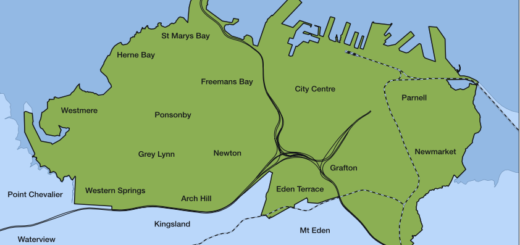Auckland’s unique heritage townscapes – if we want to keep them we may have to fight for them

The beautiful Erewan Victorian villa in Jervois Road, Herne Bay. (1905-2015), Photo Jason Oxenham NZ Herald.
It was predictable but still disappointing that Auckland Council has revealed there is no heritage merit in thousands of houses and buildings across the garden suburbs of Auckland – effectively leaving them open for demolition. The protective net temporarily cast over large parts of the older city has now been hauled in and only 18% of the housing stock within has been found to merit protection. One could argue about the assessment criteria but let us put that to one side for the moment because it is fair to point out that the news is not all bad. Fortunately for much of the inner city, the historic quarters of Ponsonby, Herne Bay, Grey Lynn, and Parnell etc, retain their existing ‘residential 1 zone’ (soon to become ‘historic character zone’) protection. Many of these zones have actually been expanded though several blocks of art deco apartments in Herne Bay inexplicably have missed out. However thanks to the hard work of the Council heritage department some extra 9000 houses across the city, previously unprotected, have been found to merit protection. It should be pointed out that in the ‘Super City’ the difference between protection and destruction can often be a slim one. Despite their historic and aesthetic merit, buildings, some of them dating back to the 19th century, have been demolished or removed on a regular basis. The recent ‘disappearing’ of the beautiful Erewan villa in Jervois Road comes to mind.
This brings me to the controversial ‘pre-1944 demolition control overlay’ that lies at the centre of the council’s present heritage protection strategy.
This has been both vaunted and criticised, as a ‘blanket control’ similar to Brisbane’s ‘pre-1940’ heritage building protection rules. I had much to do with the adoption of this measure by the Auckland Council after meeting a heritage architect from Brisbane, Peter Marquis-Kyle, after a radio interview with Chris Laidlaw. In Brisbane, as Peter told Radio NZ listeners, planning rules absolutely prohibit the demolition of any building in the inner city in existence up to 1940 (unless there are compelling grounds, like safety). Inspired by what I learned about Brisbane, I lobbied hard for a similar approach in Auckland. In this I was firmly supported by heritage advocates like Sally Hughes, Sandra Coney, Allan Matson, Shale Chambers, the Character Coalition, and the Heritage Advisory Panel backed by a public angered by the Council’s poor performance on heritage protection. What Auckland actually got however, while superficially similar to Brisbane’s – is something quite different. Unlike the Brisbane rules, all that Auckland’s so-called ‘blanket protection’ means is that before demolishing a building within the ‘pre-1944 overlay’, the owner has to obtain a resource consent. Given citizens are obliged to obtain resource consents for a whole range of routine activities, this is really no big deal. Despite this, the pre-1944 overlay has drawn heated criticism from the developer lobby led by the NZ Property Council and the other usual suspects. While pressure from vested interests is to be expected, what is really worrying is that the Auckland Unitary Plan Independent Hearings Panel, which is currently adjudicating on Auckland’s future planning rules, joined the developers’ chorus. In July the Unitary Plan Panel issued an ‘interim guidance’ to the Council warning it to drop the overlay protection. The Council has quite properly chosen to ignore this advice. To abandon the overlay process at this late stage, would have been completely farcical. All the Unitary Plan Panel has achieved, in my view, is to signal to the public that the panel is dominated by a group of deregulatory zealots. Panel members apparently believe that requiring a consent to smash down a building with prima facie evidence of heritage value places, ‘unnecessary constraints and burdens on landowners seeking to develop their property’. In the world of the Unitary Plan Independent Hearing Panel, apparently ‘property rights’ (of developers not neighbours), and money-making trump public good and Auckland’s civic responsibility to protect its unique built heritage handed down by our ancestors.
That is not I suggest the formula for a sustainable civilization – let alone a liveable city. So where do we go from here?
Auckland’s pre-1944 overlay, while a pale shadow compared to Brisbane’s straight-out ban on demolition, is at least a good start. It is proving to be coherent and robust – so far.
The next step is to ensure that those historic buildings that have been left out are put back in, and those areas and buildings that have cleared the Council’s very high assessment bar are given meaningful protection. A genuine Brisbane approach making demolition of buildings in the ‘historic character’ zones non-complying or even prohibited activity under RMA, is what we should be demanding. This is not the end of the matter because in another twist to the story, the council has informed the Unitary Plan Panel that it intends to review the previously agreed ‘single-house zones’ with the intent to reduce them from 32% of Auckland’s housing stock to just 10%. If this happens, thousands more single-house sites across the city will be opened up for mixed use, infill and high-rise. But these single-house zones also are the basis of our ‘historic character’ townscapes. There seems to be a mixed message coming from the Council. However the hardline views of the Unitary Plan Panel are quite clear and mean our historic townscapes are still under threat. The upshot of all this means that Aucklanders can not rely on what comes out of the Unitary Plan Hearing Panel to safeguard our built heritage. If we want to keep it, we may have to fight for it, quarter by quarter, street-by-street, house by house.
This story was published in the Ponsonby News November issue.



